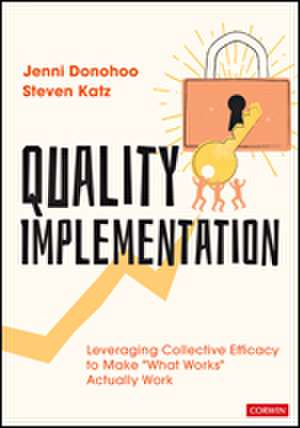Quality Implementation: Leveraging Collective Efficacy to Make "What Works" Actually Work
Autor Jenni Anne Marie Donohoo, Steven Katzen Limba Engleză Paperback – 14 oct 2019
Preț: 215.84 lei
Nou
41.30€ • 43.23$ • 34.38£
Carte disponibilă
Livrare economică 10-24 martie
Livrare express 21-27 februarie pentru 21.94 lei
Specificații
ISBN-10: 1544354258
Pagini: 128
Dimensiuni: 178 x 254 x 6 mm
Greutate: 0.27 kg
Ediția:1
Editura: SAGE Publications
Colecția Corwin
Locul publicării:Thousand Oaks, United States
Cuprins
Preface
About the Authors
PART I: BELIEFS AS THE FOUNDATION TO QUALITY IMPLEMENTATION
Chapter 1 The Elusive Quest for Quality Implementation
We Already Know What’s “Supposed” to Work in Schools
Quality Implementation Defined
The Problem of Getting to Quality Implementation
Beliefs Matter
Educators’ Beliefs
In Conclusion
Chapter 2 Why Implementation Frequently Fails
Collective Efficacy
Diminished Efficacy Is a Barrier to Quality Implementation
Collective Efficacy’s Role in Team Motivation
Diminished Collective Efficacy Results in a Reduction of Goals and Effort
Collective Efficacy Beliefs Shape Experience
In Conclusion
Chapter 3 Collective Efficacy as an Enabler of Quality Implementation
Integrating Daily Physical Activity in Elementary Schools
How Collective Efficacy Drives Quality Implementation
How Teams Exercise Control
Motivational Investments
How Goal Setting Influences Motivation
How Causal Attributions Influence Motivation
The Pygmalion Effect
In Conclusion
PART II: FOSTERING BELIEFS TO REALIZE QUALITY IMPLEMENTATION
Chapter 4 Creating Mastery Moments
Mastery Experiences
Key Features of Mastery Environments
There Is an Open-to-Learning Stance
There Is an Orientation Toward Mastery Goals
Teams Engage in Joint Work Characterized by Positive Interdependence
The Thunder Cape Rescue
Progress Is Monitored Based on Success Criteria
Implications for Practice
A Focus on Learning Together
A Focus on Cause-and-Effect Relationships
A Focus on Goal-Directed Behavior
A Focus on Purposeful Practice
In Conclusion
Chapter 5 Learning Vicariously
Key Features of Vicarious Experiences
Similarity
Reinforcement
Attention, Retention, Reproduction, and Motivation
Psychological Safety
Implications for Practice
Establishing a Culture That Enables Observational Learning
Structures and Protocols for Observational Learning
Guiding Observational Learning
In Conclusion
Chapter 6 Convincing Teams That They Have What It Takes
Social Persuasion and Affective States: Two Additional Sources of Collective Efficacy
Using Social Persuasion to Influence Collective Efficacy
Cognitive Dissonance
Social Judgment Theory
The Narrative Paradigm
In Conclusion
References
Index
Notă biografică
Jenni Donohoo is the director of Praxis-Engaging Ideas, Inc and a project manager for the Council of Ontario Directors of Education (CODE). Jenni has a PhD in Educational Studies and Supervisory Officer Qualifications. Jenni is a former classroom teacher and currently works with system, school leaders, and teachers around the world to support high quality professional learning. She has authored many peer-reviewed publications and three best-selling books, including Collaborative Inquiry for Educators, The Transformative Power of Collaborative Inquiry (with Moses Velasco), and Collective Efficacy: How Educators¿ Beliefs Impact Student Learning. Jenni¿s areas of expertise include collective efficacy, metacognition, adolescent literacy, and facilitating collaborative learning structures.
Descriere
Designed to overcome the biggest barriers to quality implementation and, thus, school improvement and student achievement, this book unpacks the powerful force of collective efficacy. The authors examine how this shared belief that the combined efforts of faculty members can positively influence student outcomes, is instrumental to establishing evidence-based practices for lasting change. In addition to a helpful conceptual framework to visualize key components, readers will discover:
• Ways to create environments that tap into mastery as the number one source of collective efficacy
• Methods to strengthen vicarious experiences through observational learning
• Examination of social persuasion and affective states as additional sources of collective efficacy
